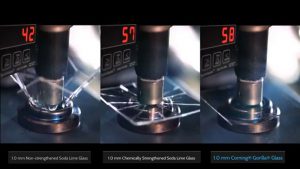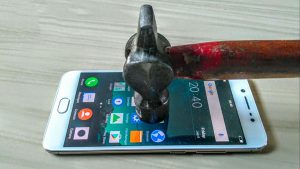 Surely you have a smartphone and you have heard about the existence of a protective glass on it called Gorilla Glass. This is the name of the technology that turns glass into a more durable and protected from scratches and cracks. Most people know this glass from smartphones and tablets, but in fact, Gorilla Glass is used in other industries as well.
Surely you have a smartphone and you have heard about the existence of a protective glass on it called Gorilla Glass. This is the name of the technology that turns glass into a more durable and protected from scratches and cracks. Most people know this glass from smartphones and tablets, but in fact, Gorilla Glass is used in other industries as well.
What is Gorilla Glass?
Glass is developed by Corning Inc. It is made from an alkaline aluminosilicate group of materials that are formed using aluminum, silicon and oxygen. You will not find this material in nature. Development started in 2005. The goal was to protect the glass from damage and scratches, so that it was lightweight and no thicker than 0.4 mm.
Gorilla Glass is not the first product of its kind from Corning. Previously, the company was known as Chemcor and was developing other types of security glass. It has been used in home appliances, ophthalmic instruments, the automotive, aerospace and pharmaceutical industries. The real success came to the company in 2010 along with smartphones.
Despite the presence of glass that cannot be broken even with a hammer, Corning does not make smartphones or tablets invulnerable. The version of the glass and other factors like its thickness are important. This glass should be treated as protection against scratches and small cracks.
Let's take a look at the differences between the different versions.
to the content
Gorilla Glass 1
The technology emerged between 2005 and 2006. It became widespread with the appearance of the first generation iPhone. This happened in 2007. The glass here was 1.5 mm thick and had an oleophobic coating that reduced fingerprints and smudges on the surface.
iPhone wasn't the only smartphone with Gorilla Glass. The first generation glass was found on about 250 smartphone models.
to the content
Gorilla Glass 2
2nd generation glass was presented at CES 2012. The strength of the glass was the same, the main difference was the thickness. It was reduced by 20%, and the glass could withstand a weight of 50 kg.
That year, Gorilla Glass 2 technology was used in 600 million devices worldwide. As glass has become thinner, thinner and lighter steel and smartphones. For example, this glass was in the Nexus 4 and Galaxy S3.
to the content
Gorilla Glass 3
3rd generation glass brought increased strength. There was also a technology called Native Damage Resistance (NDR). She made it possible to protect herself from deeper scratches. The developers claimed that the glass prevents 35% of scratches on the screen.

Here, the company has tried to increase the protection three times compared to previous versions. This was achieved thanks to a new production process. The release of the glass happened at CES 2013, it appeared in smartphones Galaxy S4, Moto G and Moto X.
to the content
Gorilla Glass 4
In 2014, the company began to pursue a new goal. One study found that 70% of phone damage is due to falls. We needed protection from them.
According to laboratory tests, the strength of the glass has doubled compared to the previous one. True, the protection was inferior to Moto ShatterShield on Moto Force smartphones. Gorilla Glass 4 models include the Galaxy Note 5 and ZenFone 2.
to the content
Gorilla Glass 5
The 5th generation has further improved the fall protection, the durability has increased by 4 times compared to the previous generation. In laboratory tests, the glass survived a fall from a height of 1.6 m. Protection against cracks was promised in 80% of cases of falling onto solid surfaces from a height of 1 m.

to the content
Is Gorilla Glass on my smartphone?
It used to be difficult to know which device versions are shipping to which countries. Many companies have released their own technology to protect against scratches and damage. For example, Dragontail technology is widely used by Chinese manufacturers. There are screens made from a combination of aluminum and sapphire crystals.
On the Corning website, you can select a device manufacturer and check if it uses Gorilla Glass and which version. In the past, manufacturers in developing countries could opt for other technologies to lower prices. Now this is much less common.
